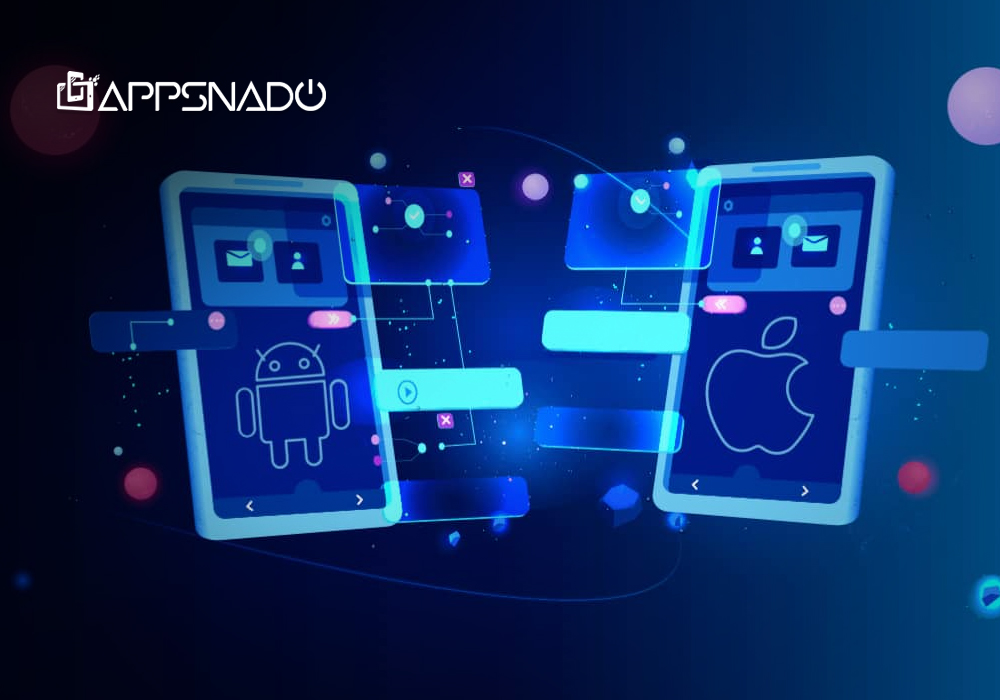Startups and even established businesses are always striving to cut costs around their operations, whether it is something tangible or abstract, such as a mobile app solution. Mobile apps have become an undeniable reality for businesses to thrive and get an edge over their competitors.
But the cost of having an app for both major platforms, i.e., Android and iOS, and the development of apps for both platforms eat so much into their budget that either they have to compromise with an inferior solution or halt the progression until they get capital. But for such situations, cross-platform mobile development is a lifesaver where businesses have an app that is capable of working on both platforms with a unified codebase.
This comprehensive blog will dive into detail, simplifying aspects of cross-platform mobile app development like what exactly it is, its advantages and disadvantages, the best cross-platform app development frameworks, and a lot more. By the end of this read, you will be able to distinguish between native and cross-platform development and make a strategic decision.
So, without further ado, let’s dive into the blog, first dissecting what exactly cross-platform app development is.
What Exactly Is Cross-Platform Mobile Development?
Cross-platform app development is the process of developing mobile applications that are capable of running different operating systems despite having a single, unified codebase. Unlike native mobile applications, instead of developing separate versions for each platform, developers have the leverage to use popular frameworks and tools to write code once and deploy it on major platforms like iOS and Android.
Cross-platform development gives developers several benefits, such as cost efficiency, faster development, and code reusability. Despite such big advantages, there are drawbacks associated with this approach, such as potential performance issues and limited access to platform-specific features. The choice between native app development and cross-platform development is subject to your preferences, budget, and requirements.
As the nature of both types of development massively differs, that is why tools are different for cross-platform development. For multi-platform development, developers utilize frameworks like Flutter, React Native, Adobe PhoneGap, Xamarin, etc., to write a codebase that is functional across the platforms.
Advantages of Cross-Platform Mobile Development
Cross-platform mobile app development brings businesses a plethora of multifaceted benefits and leverages that allure them into opting for it. Let’s dive into the top advantages.
Cost Effectiveness
The first and foremost advantage of cross-platform mobile application development is that it is done massively at less cost and with fewer resources compared to native app development, where if you want the app on both platforms, you have to separately develop the codebase, which requires more resources and time to develop and deploy. But in cross-platform app development, you are rather focusing on a single codebase and trying to make it as sturdy and optimized as possible.
Apart from that, cross-platform app development lets developers reuse a significant portion of the codebase, which also lowers development costs. This not only contributes to lower costs but also higher efficiency, making cross-platform development an absolutely attractive option.
Wide Range of Devices
When your app is accessible across devices, your user base is broadened, and you accrue a massively large number of users from across devices such as tablets, smartphones, wearables, and more. The undeniable benefit of cross-platform app development is your app’s reach to a wider audience at a much lower cost and with less effort.
With the unified codebase offered by cross-platform app development, businesses and companies can expand and stretch their reach and online presence and tap into a diverse user base on both Android and iOS. This broader market reach lets you open up unlimited opportunities for your business to acquire new users and have an increased user acquisition compared to your users, letting you have an increased market penetration.
The broader market reach is especially beneficial for startups and smaller businesses that strive to establish a digital presence across multiple platforms without spending much on their development, unlike native apps.
Check Out These
- Indie Game Development in 2024: Navigating Costs and Considerations
- Mastering The Pixel Realm: A Comprehensive Guide To 2D Game Development
- Performance Showdown: Unreal Engine 4 vs 5
Competitive Edge
Considering the multifaceted benefits of cross-platform app development, i.e., single codebase, faster time to market, etc., gives you a competitive edge over your competitors in the crowd. With multiplatform development, you have to code a single codebase that you can compare to your competitors and start catering to your audience for quick results in a market that is not saturated yet.
Faster Time-to-Market
If you opt for native mobile app development, you would need to code separate codebases that will surely take a considerable time to finish, but with cross-platform mobile development, you get the leeway in the form of a single unified codebase that can run across different platforms. Also, frameworks like React Native and Flutter let developers reuse code and offer widgets that developers can reuse, which helps them expedite the development process.
React Native has a modular architecture that allows developers to reuse the components or make little tweaks to them across the development process. On the other hand, Flutter offers widgets that developers can utilize to speed up the development process. By these frameworks, the faster delivery of cross-platform mobile application development is glorified further. With cross-platform development, you can simultaneously target multiple devices, ensuring agility that gives you an edge over your competitors.
Simplified Analytics and Data Collection
For any kind of software, analytics, and data collection are vital to understanding user behavior and patterns, preferences, and app performance. With cross-platform applications, businesses and companies have a unified code for which they have to analyze data, and because it has everything unified, from UI/UX elements to the backend, it becomes easier for businesses to gather data.
Consistent User Experience
With cross-platform mobile app development, you can easily maintain the user experience across the platforms. User experience and user satisfaction have always been the cornerstones of any product. Due to a unified codebase, you get the freedom to ensure a cohesive and seamless experience for users. With cross-platform development, you can keep unified brand experiences, letting users experience a similar interface and functionality whether they are on an iOS or Android device.
Faster Development Cycles
Cross-platform frameworks, with their modular architecture, act as catalysts to expedite the development process. Also, these frameworks allow developers to write code in a single codebase and deploy it across platforms, allowing them to have their application deployed on multiple platforms with a single codebase.
The virtue of this approach is that it massively reduces the time required to bring your app to market. This leverage of a unified codebase not only accelerates the development cycle but also simplifies maintenance and boosts the agility of development teams.
Disadvantages of Cross-Platform Mobile Development
Performance Challenges
One of the biggest concerns with cross-platform mobile development is the potential impact on your app’s performance. This is because of the use of an additional layer or framework to achieve compatibility across different platforms. In cross-platform mobile application development, there is the involvement of an abstraction layer that translates the code into native instructions.
Though this abstraction comes in handy for making code reusable, it can adversely impact the app’s performance. Native apps are usually optimized concerning a platform’s architecture, while on the other hand, in cross-platform development, the code may not be as finely tuned for each platform. This performance issue extends to the front end and the smooth rendering of graphics. This is quite true for applications like games or graphics-intensive apps, which may suffer in cross-platform development.
Limited Access to Platform-Specific Features
Cross-platform frameworks go to great lengths to provide a unified codebase for multiple platforms, but they still can’t completely replace native development. That is why they struggle to keep up with native apps in the digital landscape. As iOS and Android release new functionalities and design paradigms, cross-platform tools may not immediately support these rollouts and introductions. This can have a massive impact on the development of cutting-edge applications that go along with native applications.
This lag in feature adoption can keep you behind native applications. Apart from this, assessing platform-specific hardware features, such as advanced camera functionalities, AR capabilities, etc., requires you to do a manual and complex workaround, or even, in some cases, you need to resort to native development.
Dependency on Third-Party Frameworks
Though cross-platform frameworks are known for facilitating a unified codebase, they lack this in comparison to native apps. Therefore, your applications may face challenges in fully accessing or implementing certain features, especially features that are unique to a specific platform. This limitation arises due to differences in the architecture, APIs, or capabilities of different operation systems.
Each platform, i.e., iOS, Android, etc., has its own set of unique APIs and features that are at the core of specific strengths and functionalities of the device. Cross-platform frameworks may not always support every feature provided by these platform-specific APIs, which limits the developer’s ability to take full advantage of device capabilities.
Dependency on Platform Updates
Cross-platform development is intricately linked to the continuous evolution of native platforms. Timely updates are crucial to ensuring compatibility with the latest features, security patches, and optimizations introduced by iOS and Android. However, the dependency on framework maintainers to incorporate these updates can lead to delays.
Apps that can’t manage to adapt dynamically and quickly can miss out on the potential edge that is given by the latest platform innovation, which can adversely impact user satisfaction and the app’s market position. Also, the rapid rollout of the platform updates may seem better for your app, which can cause unforeseen challenges such as breaking changes or compatibility issues.
Debugging and Testing Challenges
Debugging and testing cross-platform apps presents unique challenges due to the intricacies of running code on different platforms with varying behavior. Identifying and resolving issues that manifest on one platform but not on others requires meticulous testing across a diverse set of devices, operating system versions, and form factors.
Cross-platform frameworks may offer debugging tools, but these might not match the sophistication and efficiency of native debugging environments. The need for comprehensive testing across multiple platforms adds to the development timeline, potentially delaying project delivery and increasing the overall cost of development.
Dependency on Third-Party Tools
Cross-platform development heavily relies on third-party frameworks and tools, introducing an additional layer of complexity and potential points of failure. The choice of a specific cross-platform framework becomes crucial, and developers must navigate the risks associated with dependencies on these tools. Issues such as compatibility challenges with the latest platform updates, limited community support, or the discontinuation of a framework can significantly impact the project’s long-term viability. Moreover, incorporating third-party tools may lead to larger app sizes, slower build times, and potential integration challenges, further complicating the development process.
User Interface Consistency
Achieving a consistent user interface (UI) across iOS and Android, each with its own design guidelines and user expectations poses a considerable challenge in cross-platform development. While frameworks are known for abstracting away platform differences, achieving pixel-perfect consistency may be impractical, which is achievable in native app development.
UI compromises may be necessary to accommodate platform-specific design patterns and aesthetics, potentially resulting in an interface that feels less native on both platforms. Design elements that seamlessly integrate with the native look and feel of each operating system might be challenging to implement, impacting the app’s overall user experience and aesthetic appeal.
Learning Curve and Skill Set
Developers transitioning to cross-platform development need to invest time in learning hard-core expertise in the chosen framework and other related technologies. While these frameworks have the objective of streamlining the development process, they come with their own set of complexities, concepts, patterns, and best practices that developers need to learn to excel at coding a top-tier app.
The learning curve becomes harder, and developers have to keep learning to ensure they are staying abreast of updates and improvements and coding an industry-standard application. Developers who learn these skills may not find them handy when coding or transferring to native app development; that kind of limits developers’ flexibility and career opportunities in projects.
Check Out These:
- Quality Control Vs Quality Assurance
- Top 5 Methods for Creating iOS Apps on a Windows Platform
- How to Build a Successful Augmented Reality App: A Step-by-Step Guide
- Flutter vs. Swift: Navigating The Crossroads Of Mobile App Development
Benefits of Cross-platform Mobile App Development for Developers
Code Reusability
Due to the frameworks that are used in cross-platform mobile app development, such as React Native, Flutter, or Xamarin, developers can write a unified codebase. Unlike native app development, where developers don’t get much leeway to reuse code, cross-platform mobile application development gives developers leverage to reuse code wherever possible. This code reusability feature massively reduces development time, effort, and cost.
Rapid Prototyping and Iteration
Cross-platform development contributes to fast prototyping and iteration, letting developers quickly test and improve apps without having to put much effort into native development. As developers keep refining, the results instantly and simultaneously appear on both iOS and Android, which accelerates the feedback loop for developers so they can rapidly refine the concept. This counts as a strategic advantage, especially where apps are rapidly being rolled out in app stores.
Single Codebase Maintenance
Assuming you have two codebases for two different platforms, it must be difficult to release updates and simultaneously maintain consistency across both platforms, right? But with cross-platform development, maintaining a single codebase also becomes drastically streamlined, which helps you maintain uniform app performance on both platforms. This simplified maintenance approach lets developers ensure that updates, patches, and implementations of new features are applied consistently across all platforms.
Easier Team Collaboration
Due to the nature of frameworks like JavaScript (React Native), Dart (Flutter), or C# (Xamarin), developers are facilitated in the bigger scheme of things. With cross-platform mobile app development, team collaboration is promoted among developers from different backgrounds and skill sets. Different teams can work seamlessly and cohesively on a single shared codebase. This unified development not only makes delivery faster but also fosters knowledge sharing and collaboration. These collaborative aspects come in handy for large development teams working on big projects.
Best Cross cross-platform app Development Framework
Below are the top cross-platform app development frameworks that are widely in use today.
React Native
React Native was developed and is being maintained by Facebook. React Native is known for its prowess in letting developers create dynamic and responsive user interfaces. It allows developers to use a single codebase written in JavaScript to build apps for both iOS and Android. There are many notable features of React Native, such as a single codebase, hot reloading, etc.
Developers are often found praising React Native for its hot reloading feature, which lets developers see real-time changes without having to reload the app and rebuild the entire app. It also has a large and active community that massively contributes to the wealth of resources for developers and third-party libraries.
Flutter
Just like React Native, Flutter was also created by Google, and Google is still maintaining it. It is famous for its beautiful and customizable user interfaces. It uses the Dart programming language and offers a rich set of pre-designed widgets that facilitate developers by making it easy to create visually appealing apps.
Just like React Natuve’s hot reload, Flutter’s “hot reload” feature also allows developers to experiment and see changes instantly. Flutter, arguably after React Native, is in second place for delivering high performance and is popular for creating immersive and expressive applications.
Xamarin
Just like React Native and Flutter, Xamrin is also owned by a giant, Microsoft. Xamarin allows developers to use C# to develop cross-platform applications. It is known for offering a native-like user experience by giving developers access to native APIs. Features such as Xamarin. Forms allow for code sharing across platforms and Xamarin. iOS and Xamarin. Android gives humongous freedom in enabling more platform-specific customization when needed.
Guide to Choosing Cross-Platform Services
If you find features of cross-platform app development lucrative but want one that is highly adaptive across the platforms but with a premium, consider opting for nearshore mobile app development in Mexico. There are many reasons why you should do so. First is the premium-quality end product that lives up to your expectations. Second is the significantly lower development cost while having a top-tier-quality mobile application. Lately, Mexico has been a hot hub for its IT exports to different regions, including American and European countries.
Whether you are wondering what is AR zone or need guidance on anything, it is preferred to first go through a consultation to understand the complexities of the technology. As the development costs in the USA and European countries can make a hole in the pocket, businesses and companies, especially startups, try to get their app developed by a service provider in Mexico.
So, if you are a novice in this realm, it is recommended to hire for mobile development and consulting rather than handing over your project.
Cross-Platform Development Cost
So you are a business that wants to get cross-platform built and have the query, “How much does it cost to hire an app developer?” Well, the best cross platform app development answer is not simple, and many factors contribute to the cost of app development, from the complexity of your project to the frameworks and tools you want to use to build the app to the region you are hiring developers from. If you get an app developed in some Asian country, you will get the same quality as in America or Europe, but at a way lower cost, as the cost of living in the region massively impacts the development cost.
It also depends on the framework being used to code the weaves of your app, so today some frameworks’ developers demand high per-hour wages. Assume you keep options like React Native and Flutter aside and choose AngularJS mobile app development for your app; chances are it is going to cost a lot as the saturation of developers in AngularJS is lower than the former two.
Conclusion
The decision about cross-platform mobile development has to be strategic and needs to be taken with all the pros and cons. It comes with its advantages and disadvantages. If you choose multi-platform app development, you will benefit from perks like getting a competitive edge, early time to market, cost-effectiveness, assistance with maintaining brand consistency, code reusability, uniformity across platforms on updating codebase, quick deployment, etc.
The drawbacks of cross-platform app development are missing out on absolute native features, performance tradeoffs, slow performance, time in rolling out new features, test complexity, etc. Cross-platform mobile app development is highly in demand for its multifaceted benefits. It is an exceptional gateway for businesses looking for a wider reach without needing to put much effort into development.







